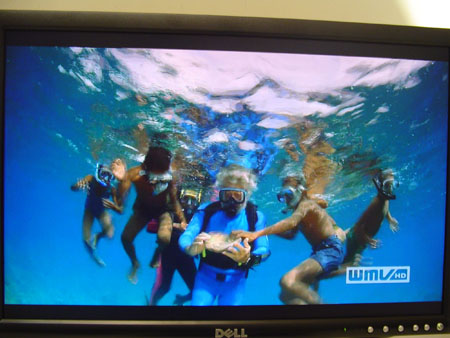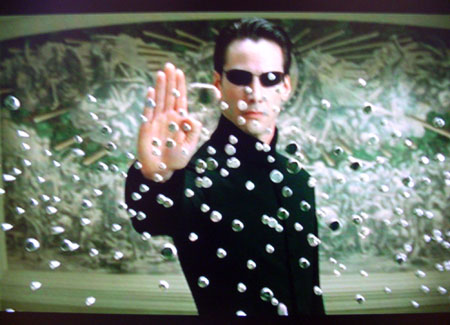The 20" LCD Shootout: Dell versus Apple
by Kristopher Kubicki on April 27, 2005 12:05 AM EST- Posted in
- Displays
Application Analysis
The core of our LCD benchmarking comes from real application analysis. We play with a lot of monitors and it gets easier for us each time to pick out problems with an LCD just by using the right application. Here are a few quick looks at some demanding full screen applications. We already ran ColorVision's OptiCal software, so all of our monitors are calibrated and adjusted to the same curves.High Definition Video – We played the WMV9 1080p and 720p versions of “Under Sea Adventure” to give our monitor a little taste of high definition video. In many of our previous analyses, we simply ran WMV9 content unscaled to test color depth and clarity. However, since both the Apple Cinema and Dell 2005FPW are capable of widescreen unscaled aspect ratios (at least for 720p), we thought it best to put both of these monitors completely through their paces. No surprise, but there doesn’t seem to be any corruption or shifts in any of the colors. However, keep in mind that neither of these displays supports HDCP! We could not watch 1080i or 720p signals on either display from a regular Comcast HD receiver, since neither display has a DVI-HDCP input. While pin compatible, any HDCP source simply terminates after a few seconds of video. The Dell 2005FPW has a few additional inputs, so we can actually use a component-to-VGA (15-pin D-sub) cable and watch HD content in this manner. Of course, for the same reason why we don’t encourage anyone to use 15-pin D-sub cables for regular computer use, we really don’t recommend D-sub for TV either if it can be avoided. Unfortunately, in this scenario, it cannot.
The Matrix Reload, The Matrix - We use the Matrix series to test full motion video on our LCDs. Since the Matrix isn't the best movie to test color reproduction, we typically only look for motion blur on gray-to-gray transitions or other imperfections in the signal. Both displays demonstrated accurate sharpness, although we noticed that the slightly duller Apple display had more of a “washed out” look to it in comparison to the Dell 2005FPW. Typically, we only see this on brighter LCDs with lower contrast ratios. Since the Apple 2005FPW has a (very) slight lower measured contrast ratio, this didn’t surprise us during out testing.
World of Warcraft – Although I didn’t personally start playing World of Warcraft until Anand published his Performance Guide, WOW happens to be one of the most perfect games to test LCD gaming. The fairly rich color palette, high motion objects and often contrasting lights and darks make the game a perfect haven to really put a display to its limits. (Unfortunately, once you turn it on, it also becomes nearly impossible to stop playing and start writing). Putting our displays into mirroring mode and playing for a few hours really stresses the importance of good color calibration in game settings; for example, it became almost impossible to differentiate portions of the grass needed to be selected for a quest on both LCDs before calibration through ColorVision’s OptiCal. Because both monitors were using DVI connectors, these changes had to be made to the color curves on the PC because the functionality is disabled on the monitors.
Max Payne 2 - The extreme light and dark transitions in Max Payne still provide us with the sufficient criteria to benchmark transient response time; specifically, we can focus on the light and dark extremes. We detected no red shift (as we usually do on this game for PVA displays), and had no problem with motion blur.
Photoshop CS – We typically don’t mention applications like Photoshop, but while using some of our new found desktop space, we took to advanced features in Photoshop like a fish in water. It’s no surprise that high end graphics (and, of course, video) are done on these displays; the higher resolution and wider room allow us to spread the tool bars out further while giving us more room to work. Widescreen displays feel awkward at first, but given hours of tinkering and readjusting, the additional room feels almost necessary.













70 Comments
View All Comments
nels0360 - Wednesday, April 27, 2005 - link
I have a Dell 2005FPW and I love it. One thing though. The brightness setting on it (and all others) is worthless. It's either bright or really bright! Not a big problem for me but it does lead to eye fatigue if used in a dark room (like for gaming).IceWindius - Wednesday, April 27, 2005 - link
After days of research, I got the Hyundai L90D+ and I couldn't be happier. Dell just isn't one for quality assurance.Ahkorishaan - Wednesday, April 27, 2005 - link
Page 8, there is a typo at the end of the Matrix spiel,"Since the Apple 2005FPW has a (very) slight lower measured contrast ratio, this didn’t surprise us during out testing."
Otherwise, great review.
ArtOfWar - Wednesday, April 27, 2005 - link
http://www2.newegg.com/Product/Product.asp?Item=N8...That Acer display looks pretty good too... maybe you could add it to the review... suince in looks (aesthetics) it's better than both these display IMO (thou both of these look awesome)
Anywyas great review... Wish I could afford one of those
KristopherKubicki - Wednesday, April 27, 2005 - link
kini62: Thanks for the update; I've corrected that.Kristopher
kini62 - Wednesday, April 27, 2005 - link
You said that NO games use 1680x1050. Half Life 2 and Far Cry both support that resolution.Anemone - Wednesday, April 27, 2005 - link
Rats wish you would also put the 2405 under the microscope too :)Loved every page of the article even still.
Novaoblivion - Wednesday, April 27, 2005 - link
I have a 2005FPW as does my brother and we both love them they work great :)Zerhyn - Wednesday, April 27, 2005 - link
"We were very surprised to learn that the Apple Cinema 20” display only comes with a one-year limited warranty, if you do not purchase the display with a PowerBook or PowerMac. Dell displays all come with a three-year limited warranty."In the spec charts it says the apple has a 3 year warrenty and the dell only a one year....
MekkelRichards - Tuesday, May 5, 2020 - link
I bought this monitor when it came out in 2005 for $422, and I am still using it in 2020.That's 15 years of usage!